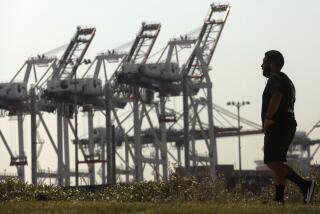The great smoke-out
- Share via
By now, most of us are keenly aware that emissions resulting from the burning of fossil fuels are causing our planet to heat up, altering our climate and putting the survival of plants, animals and even humans in peril. But what we don’t really know is whether it is still possible to stop those emissions and reverse the problem.
Now, it turns out, a great experiment is about to be performed, at enormous financial cost, providing a once-in-a-lifetime opportunity for science. Several weeks before the 2008 Summer Olympics, in an effort to make Beijing more palatable to foreign visitors, the government of China will begin shutting down industries that emit vast quantities of soot and carbon into the atmosphere surrounding the city.
Though the government has yet to release a list of the industries and factories it will close, various news accounts and official statements indicate that virtually every factory in the greater Beijing area will greatly reduce operations or be completely shuttered for a period of several weeks, and that coal mining operations in nearby Shanxi province may be shut down as well, or at least slowed, before and throughout the Olympics. In addition, auto traffic will be severely curtailed within Beijing, and clouds may be seeded to the north of the city in order to minimize the hideous Mongolian dust storms that commonly plague China’s capital.
The effect could be enormous. As much as 25% of the air pollution in Los Angeles comes from China; at certain sites in California, as much as 40% of the air pollution comes from Asia. When the Chinese undertake this enormous, if short-term, change in their emissions, it will send a signal across the ocean to the U.S. that the control of air pollution in one part of the world can in fact affect the atmosphere on the other side of the globe. If we can detect a change in China’s emissions as far away as the United States, the great experiment will dramatically illustrate that our choices about emissions can transform the health of the planet.
The last time a highly polluted city offered the world such a dramatic opportunity to witness the daily effect of its industrial and auto emissions was in 1984, on the occasion of the Los Angeles Olympics, during which similarly radical measures were taken to offset Southern California’s smog. One of us (Garrett) was a reporter for National Public Radio in those days, covering the Olympics, and well recalls the moment when a clear view of the entire Los Angeles Basin, San Gabriel Mountain range and even hints of the deserts beyond miraculously appeared through a Venice Beach window.
For Angelenos, the radical measures taken to reduce auto traffic and industrial smog during the 1984 Olympics provided dramatic evidence that pollution could, in fact, be curbed through force of will. To a striking degree, the clean air experienced during the Olympics pushed political leaders throughout California to acknowledge the dangerous trajectory of the state’s continued reliance on carbon-emitting automobiles -- and to take steps to reverse it.
Beijing -- the modern city that viewers will, to their amazement, see on TV during the Olympics -- is largely modeled on Los Angeles. It is a city of freeways, auto-dependency and gated suburbs, some of which are named after communities in the San Fernando Valley. And though this transformation from bicycle-commuting city to car-dependent metropolis has occurred in a single generation, Beijing already suffers traffic congestion so severe that cars sometimes idle on the new freeways for hours, emitting tons of carbon-based pollutants and producing classic smog. Surrounding Beijing are industrial parks that combine the high-tech, trichloroethylene-emitting factories of Silicon Valley with the heavy manufacturing, soot-saturated steel foundries of early 20th century Pittsburgh.
For a few precious weeks in July and August, this will all be shut down or severely reduced. Because China hopes to impress the more than 2 billion television viewers gazing, awe-struck, at the New China, other major cities in the country will be encouraged to lower their pollution output as well.
It would be impossible to overstate the significance the Chinese leadership has placed on the Olympics, and it is clear that the Communist Party simply will not allow carbon monoxide, soot or smog to mar what it views as the most historic event of recent decades.
The scientific community should plan immediately to take advantage of this monumental experiment, mobilizing to measure the effect by studying pollution levels before, during and after the great shutdown. Congress and the European Union should allot emergency funding to support NASA, the National Center for Atmospheric Research and European Union satellite observations and air sampling from aircraft, documenting the effects not only on China but on places as far away as Hawaii and Los Angeles.
Ground-level and high-elevation measurements of pollutants, including aerosolized soot, should be taken all summer throughout Asia, particularly downwind from Beijing. Ozone, carbon monoxide and carbon dioxide should be measured daily, perhaps even hourly, in the U.S. and other locations deeply affected by Chinese pollution, such as Hong Kong, the Maldives, Singapore, South Korea and Japan.
Public health experts should set up emergency-room monitoring inside Beijing and regionally throughout the summer, watching for any declines in admissions for respiratory ailments. Anthropologists and sociologists should set up cohorts of Beijing residents, representing a broad social spectrum, analyzing their reactions to the shutdown. The data should be archived and made public so researchers around the world can draw every possible inference. The Google Foundation, Sir Richard Branson and other donors who have made climate change a priority should step up to the plate, helping provide the millions of dollars it will require to document this event.
It is probable that the Beijing shutdown will prove even more dramatic than the 1984 anti-smog effort in L.A. Certainly the air pollution in Beijing is far worse than it was in Los Angeles. But the effect of the shutdown on the political and economic policies of world leaders cannot be measured without data.
If, as many scientists believe will be the case, the shutdown markedly reduces air pollution levels across Asia and the Pacific, demonstrably reduces aerosol emissions that imperil the survival of the Himalayan glaciers (and are breathed by billions of people across the globe) and decreases hospital admissions for acute asthma in China and its neighbors, it may also prove a turning point in world history.
This opportunity will go undocumented, however, unless the world community mobilizes its scientific and funding resources immediately.
More to Read
Go beyond the scoreboard
Get the latest on L.A.'s teams in the daily Sports Report newsletter.
You may occasionally receive promotional content from the Los Angeles Times.






